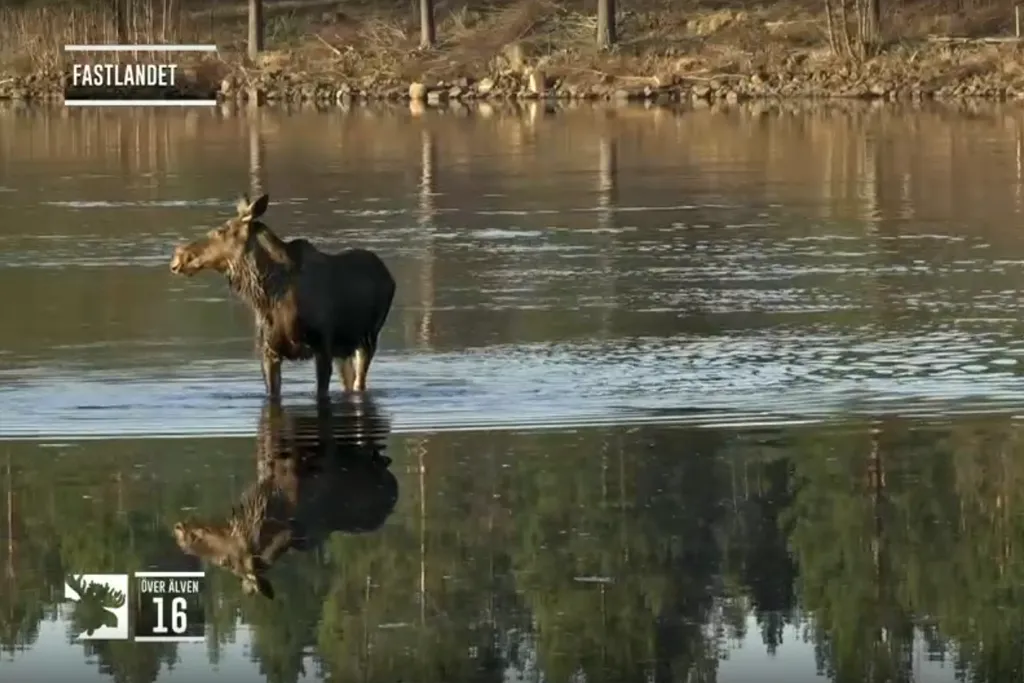
Watch Majestic Moose Meander North With This Popular Live Stream From Sweden
www.smithsonianmag.com
Watch Majestic Moose Meander North With This Popular Live Stream From Sweden
“The Great Moose Migration” shows the antler-adorned ungulates making their annual spring trek
Last year, nine million viewers tuned in to watch “The Great Moose Migration” in Sweden.
SVT Play
Every spring, Sweden’s moose head north to their lush, green, summer grazing pastures. To reach their intended destination, dozens must swim across the scenic Ångerman River—and, as they do, they’re blissfully unaware that millions of people are watching their every move.
“The Great Moose Migration”—a 24-hour live stream that lasts for roughly three weeks—is back up and running as so many Alces alces make their annual spring trek northward. Moose fanatics around the world are now tuning in at all hours of the day and night, hoping to catch a glimpse of these iconic hoofed mammals.
The stream, called “Den stora älgvandringen” in Swedish, is produced by national broadcaster SVT for its streaming platform SVT Play.
When SVT first launched the moose live stream in 2019, it attracted nearly a million viewers. But it quickly skyrocketed in popularity, ballooning to nine million viewers in 2024.
This year, the live stream launched a week early because the moose were already on the move, likely due to warm weather. The show is scheduled to continue through May 4.
De första älgarna simmar över | Den stora älgvandringen | SVT
Watch on
Producers go to great lengths to provide the live stream. They’ve set up 26 remote cameras and seven night cameras along the moose migration path in northern Sweden, connected by nearly 12 miles of cable. Once the stream is running, they also deploy a drone to get overhead shots.
More than a dozen crew members work out of a broadcast control room in Umeå, a city in east-central Sweden, monitoring the camera feeds and switching between them when they spot something interesting. Last year, they aired 506 hours of footage.
Sometimes, they spy an object that looks like a moose but actually turns out to be a rock. They’ve dubbed these moments “near-moose experiences,” says Goran Ericsson, a moose researcher at the Swedish University of Agricultural Sciences, to the New York Times’ Amelia Nierenberg and Christina Anderson.
Even when the stream is devoid of moose, viewers can’t seem to tear themselves away. Perhaps it’s because Sweden’s landscapes are beautiful on their own. The cameras show towering evergreen trees, tranquil waterways and, at night, the northern lights.
But experts suspect something more might be going on. The live stream may be an antidote to the stressors of the modern world, they posit—a calming, soothing source of entertainment, without any dialogue or plot points.
“It became, in a strange way, gripping because nothing catastrophic is happening, nothing spectacular is happening,” says Annette Hill, a media and communications scholar at Sweden’s Jönköping University, to the Associated Press’ Stefanie Dazio. “But something very beautiful is happening in that minute-by-minute moment.”
The live stream also provides a sense of camaraderie. More than 79,000 fans have joined a Facebook group called “We who like the great moose migration on SVT!” (“Vi som gillar den stora algvandringen pa SVT!” in Swedish), where they share clips from their favorite moments. The live stream also has a chat function, and it shows the number of viewers watching at any given time.
Though most viewers are watching separately, often from the comfort of their own homes, they connect virtually with their fellow moose-lovers in a way that makes them feel hopeful and optimistic.
“When you’re in this chat you forget that there are bad things in the world,” says Marianne Hauger, a 49-year-old who lives on the Swedish island of Trundon, to the New York Times.
Moose aside, several other wildlife-themed live streams have caught the world’s attention in recent years. Viewers can help with the annual fish migration in the Netherlands by watching live footage from an underwater camera—and pressing a digital “fish doorbell” when they see a fish waiting to pass through a boat lock.
Last summer, researchers in Colorado pointed a camera at a “mega den” of 2,000 pregnant rattlesnakes and encouraged viewers to report their behaviors. The leaders of the citizen science initiative also hoped to change the public’s perception of the slithery creatures.
In Canada, an annual live stream captures the summer migration of tens of thousands of chatty beluga whales. In the fall, similar feeds show polar bears congregating in Churchill, Manitoba, as they wait for sea ice to form on Hudson Bay.
Across the country, viewers are also tuning in to watch various birds of prey lay eggs and raise chicks. Two of the most famous are Jackie and Shadow, a pair of bald eagles living in California’s Big Bear Valley.
And, at Alaska’s Katmai National Park and Preserve, the installation of several live cameras along the Brooks River helped give rise to the wildly popular Fat Bear Week.
Get the latest stories in your inbox every weekday.
More about:
Animals
Migration
Technology
Wildlife
0 Comentários
·0 Compartilhamentos
·0 Anterior



